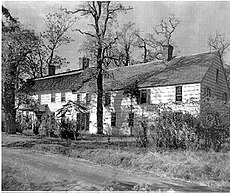Nathaniel Woodhull
Nathaniel Woodhull | |
|---|---|
 The capture of Nathaniel Woodhull | |
| Born | 30 December 1722 Mastic, New York, British America |
| Died | 20 September 1776 (aged 53) New Utrecht, New York, U.S. |
| Allegiance | |
| Years of service |
|

Nathaniel Woodhull (December 30, 1722 – September 20, 1776) was a leader of the New York Provincial Congress and a brigadier general of the New York Militia during the American Revolution.
Biography
[edit]
Woodhull was born on December 30, 1722, in Mastic, Province of New York to Nathaniel Woodhull and Sarah Smith Woodhull. His family had been prominent in New York affairs since the mid seventeenth century.
In 1758, the thirty-six year old Woodhull joined the New York provincial forces, where he held the rank of major. He fought in numerous battles during the 7 Years War. He was at the Battle of Carillon under General Abercromby, and at the Battle of Fort Frontenac under General Bradstreet. In 1760, as colonel of the 3rd Regiment of New York Provincials took part in the invasion of Canada under General Amherst. After the end of hostilities, he returned to farming and community affairs.
In 1761, he married Ruth Floyd, the sister of William Floyd, a signer of the Declaration of Independence. Sentiment against England's taxation of the colonies led to Suffolk County electing Woodhull to Province of New York assembly. From 1769 to 1775, he served as a member of the Province of New York assembly for Suffolk County. As such, he spoke against the Crown's colonial policies. He represented Suffolk also in the convention which chose delegates to the First Continental Congress, and in the New York Provincial Congress. In May 1775, the Provincial Congress assumed control of the colony and reorganized the militia. In August 1775, Woodhull was elected president of the New York Provincial Congress.
Battle of Brooklyn
[edit]In October 1775, he was made brigadier general of the Suffolk and Queen's County militia. In August 1776, on the eve of the Battle of Long Island, Woodhull's militia was detailed to drive livestock east to prevent its falling into British hands. Woodhull's troops had driven 1,400 cattle out onto the Hempstead Plains and with 300 more ready to go. A severe thunderstorm drove the general to take refuge in a tavern run by Increase Carpenter, about two miles east of Jamaica in what is now Hollis. Relief was not forthcoming, and his situation deteriorated.


Woodhull was captured near Jamaica by a detachment of Fraser's Highlanders led by Captain Sir James Baird. He was struck with a sword multiple times, injuring his arm and head by a British officer purportedly for not saying, "God save the King", as ordered, saying instead "God save us all". He was taken in a cattle transport to the Old Stone Church in Jamaica, which the British had converted into a prison.[1] He was later moved to a brig serving as a prison ship in Wallabout Bay. While in captivity, Woodhull's wounds became infected and his health rapidly deteriorated. A sympathetic British officer had him transferred to the century-old house built by Nicasius di Sille in New Utrecht (now part of Brooklyn). [a] Woodhull's arm was amputated in an effort to save his life, he managed to call for his wife who was at his side when he died on September 20, 1776. He was buried at his family home.[2]
Legacy
[edit]
The following schools are named after Nathaniel Woodhull:
- PS 35 Nathaniel Woodhull School, Hollis, Queens[3]
- Nathaniel Woodhull Elementary School, Shirley, New York[4]
- Nathaniel Woodhull Intermediate School, Huntington, New York[5]
The post office in Mastic Beach, New York is also named after Nathaniel Woodhull.[6]
Notes
[edit]- ^ The house was demolished in 1850 by the owner Baret Wyckoff. It was located in the current vicinity of 84th St. and New Utrecht Ave.
References
[edit]- ^ Lossing, Benson J. (1860). The Pictorial Field-book of the Revolution Vol II. Franklin Square, New York: Harper & Brothers. p. 605.
- ^ Woodhull Family
- ^ Nathaniel Woodhull School, Hollis
- ^ Nathaniel Woodhull Elementary School, Shirley, New York
- ^ "Woodhull Intermediate School". www.hufsd.edu. Retrieved 2016-10-03.
- ^ "Congressional Record (Bound Edition), Volume 158 (2012), Part 11 - BRIGADIER GENERAL NATHANIEL WOODHULL POST OFFICE BUILDING". www.govinfo.gov. Retrieved 2021-12-11.
- Jacobsen, Edna L. "Nathaniel Woodhull." Dictionary of American Biography Base Set. American Council of Learned Societies, 1928-1936. Reproduced in Biography Resource Center. Farmington Hills, Mich.: Gale, 2008. Online April 1, 2008.
- 1722 births
- 1776 deaths
- Members of the New York General Assembly
- Members of the New York Provincial Assembly
- Members of the New York Provincial Congress
- United States military personnel killed in the American Revolutionary War
- Militia generals in the American Revolution
- New York (state) militiamen in the American Revolution
- People from Mastic, New York
- People from colonial New York
- Woodhull family
- 18th-century American politicians
